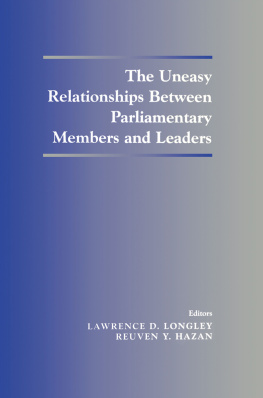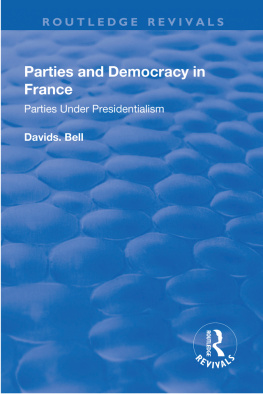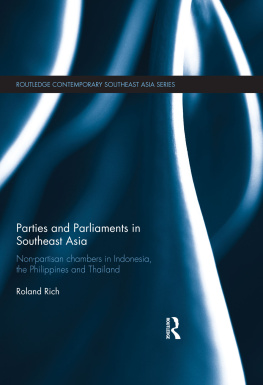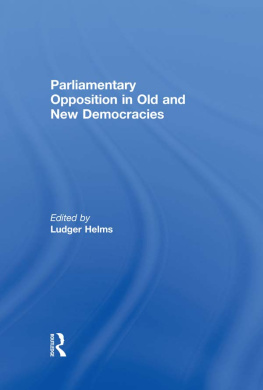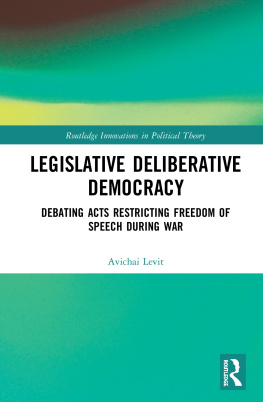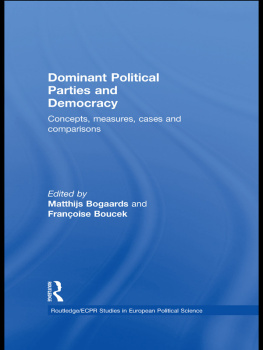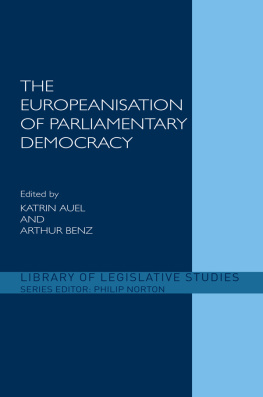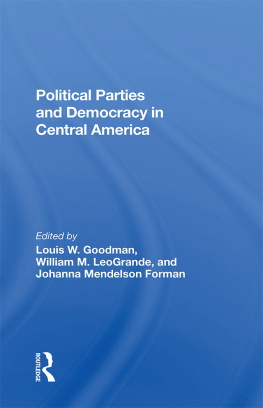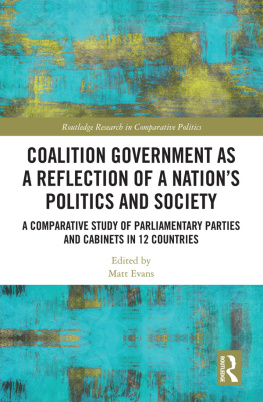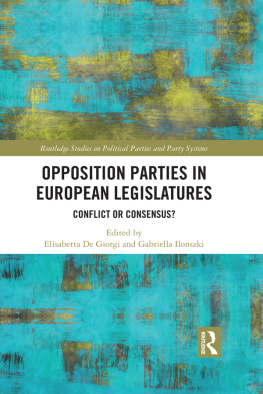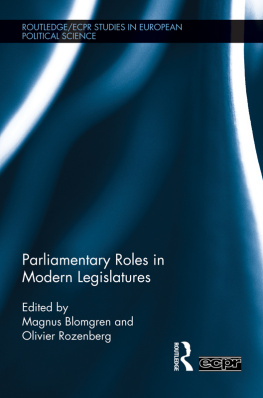Cohesion and Discipline in Legislatures
The existence of noticeable unified parties is central to the theory and practice of democracy in general, and to parliamentary democracy in particular. However, legislative studies scholars have good reason to cease treating parties as monolithic, unitary actors, for they evidently are not. The first step in this direction is to ask why one of the distinguishing features of modern political parties is their legislative unity. Do parties enter parliament as unified actors, or are they moulded into this model by the legislature? The answer depends on whether one is looking at cohesion or at discipline. The goal of this collection of articles is to present a conceptual delineation between these two key concepts.
This book was previously published as a special issue of The Journal of Legislative Studies.
Reuven Y. Hazan is a Senior Lecturer in the Department of Political Science at the Hebrew University of Jerusalem. He is the author of Centre Parties: Polarization and Competition in European Parliamentary Democracies (2000) and Reforming Parliamentary Committees: Israel in Comparative Perspective (2001).
THE LIBRARY OF LEGISLATIVE STUDIES
General Editor Philip Norton
ISSN 1460-9649
A series of new and recent books exploring the role of legislature in contemporary political systems.
The volumes typically draw together a team of country specialist to provide in-depth analysis.
Parliaments in Contemporary Western Europe
Edited by Philip Norton
Volume 1: Parliaments and Governments in Western Europe
Volume 2: Parliaments and Pressure Groups in Western Europe
Volume 3: Parliaments and Citizens in Western Europe
Second Chambers
Edited by Nicholas D.J. Baldwin and Donald Shell
Delegation and Accountability in European Integration
The Nordic Parliamentary Democracies and the European Union
Edited by Torbjrn Bergman and Erik Damgaard
The Uneasy Relationships between Parliamentary Members and Leaders
Edited by Lawrence D. Longley and Reuven Y. Hazan
Parliaments in Asia
Edited by Philip Norton and Nizam Ahmed
Conscience and Parliament
Edited by Philip Cowley
The New Roles of Parliamentary Committees
Edited by Lawrence D. Longley and Roger H. Davidson
Members of Parliament in Western Europe
Roles and Behaviour
Edited by Wolfgang C. Mller and Thomas Saalfeld
Parliaments in Western Europe
Edited by Philip Norton
The New Parliaments of Central and Eastern Europe
Edited by David M. Olson and Philip Norton
National Parliaments and the European Union
Edited by Philip Norton
Cohesion and Discipline in Legislatures
Political Parties, Party Leadership,
Parliamentary Committees and Governance
Edited by
Reuven Y. Hazan
First published 2006 by Routledge
2 Park Square, Milton Park, Abingdon, Oxon, OX14 4RN
Simultaneously published in the USA and Canada
by Routledge
270 Madison Avenue, New York, NY 10016
Routledge is an imprint of the Taylor & Francis Group
2006 Reuven Y. Hazan
Typeset in Times by Techset Composition Limited
All rights reserved. No part of this book may be reprinted or reproduced or
utilised in any form or by any electronic, mechanical, or other means, now
known or hereafter invented, including photocopying and recording, or in
any information storage or retrieval system, without permission in writing
from the publishers.
British Library Cataloguing in Publication Data
A catalogue record for this book is available from the British Library
Library of Congress Cataloging in Publication Data
A catalog record for this book has been requested
ISBN: 0-415-36014-5 (hbk)
Contents
| Reuven Y. Hazan |
| John E. Owens |
| Barbara Sinclair |
| Philip Norton |
| David Arter |
| Louise K. Davidson-Schmich |
| Werner J. Patzelt |
| Jonathan Malloy |
| Sam Depauw |
| Herbert Dring |
| David M. Olson |
REUVEN Y. HAZAN
The last decades of the twentieth century saw a world of remarkable transformation and re-establishment of parliaments, as existing legislatures were rebuilt and new ones built. Contrary to the literature of the 1960s and 1970s on the decline of parliaments, legislatures have actually innovated their institutional structures and developed new and vital political roles. Parliaments have thus become almost ubiquitous as institutions of modern governance.
If Lijphart was correct when he argued, Legislatures should probably be regarded as the most important institutions in a democracy,1 then it is essential to assess the most crucial functional organs of these influential bodies the political parties. For, as Schattschneider declared, Modern democracy is unthinkable save in terms of the parties.2 Modern representative government has become party government, for good and for bad, and thus the basic pre-condition for the establishment and survival of governments depends on the ability of the political parties to control their representatives, to aggregate positions and policies, to present a coherent ideological image, to operate effectively in the legislative arena and to function as a stable basis for the political process.
The existence of noticeably unified parties is central to the theory and practice of democracy in general, and to parliamentary democracy in particular. However, according to Bowler, Farrell and Katz, because this hidden assumption has reached normative status for a variety of scholars, its study is relatively underdeveloped.3 Legislative studies scholars have good reason to cease treating parties as monolithic, unitary actors, for they evidently are not. As Laver and Shepsle declared, We need a model of intra-party politics before we can develop a realistic model of inter-party competition.4 The first step in this direction is to ask why one of the distinguishing features of modern political parties is their legislative unity. Do parties enter parliament as unified actors, or are they moulded into this model by the legislature? The answer depends on whether one is looking at cohesion or at discipline.
Copeland and Patterson stated
The task of political inquiry is to test the validity of claims for the way things work in one system by subjecting these claims to analysis in other systems & Cross-national research on parliamentary institutions and behavior is not easy, but analyzing a number of such institutions using the same conceptual apparatus or research design will contribute mightily to addressing interesting questions about political representation.5
The goal of this introductory article, and the entire collection of articles in this volume, is to do exactly that, to present a conceptual delineation that will then be subjected to analysis across several countries and at various levels, in order to assess its validity.
THE DISTINCTION OUTLINED: PARTY COHESION VERSUS LEGISLATIVE DISCIPLINE
Although it is common in the literature to distinguish between party cohesion and party discipline, the terms are rarely delineated properly or distinguished adequately. Prominent scholars use these two terms interchangeably. Articles, chapters and books have displayed one of these terms in their title while constantly referring to the other throughout the text. Sometimes the two terms appear together, in the same sentence, as if they are one and the same. The delineation presented herein has two associated goals. The first is to revisit these two basic concepts that were at the forefront of legislative research a generation ago, but have fallen from grace recently. Second is the attempt to divorce them, and to present a distinction that will be addressed in the subsequent articles.


